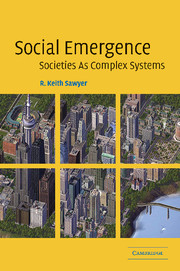Book contents
- Frontmatter
- Contents
- List of figures and tables
- Acknowledgments
- 1 Emergence, complexity, and social science
- 2 The third wave of social systems theory
- 3 The history of emergence
- 4 Emergence in psychology
- 5 Emergence in sociology
- 6 Durkheim's theory of social emergence
- 7 Emergence and elisionism
- 8 Simulating social emergence with artificial societies
- 9 Communication and improvisation
- 10 The Emergence Paradigm
- References
- Index
8 - Simulating social emergence with artificial societies
Published online by Cambridge University Press: 10 May 2010
- Frontmatter
- Contents
- List of figures and tables
- Acknowledgments
- 1 Emergence, complexity, and social science
- 2 The third wave of social systems theory
- 3 The history of emergence
- 4 Emergence in psychology
- 5 Emergence in sociology
- 6 Durkheim's theory of social emergence
- 7 Emergence and elisionism
- 8 Simulating social emergence with artificial societies
- 9 Communication and improvisation
- 10 The Emergence Paradigm
- References
- Index
Summary
In this chapter, I examine a new computer simulation technology that has increasingly been used to simulate social emergence: multi-agent systems (MASs). Until the development of MASs in the 1990s, computer simulations of social phenomena primarily used analytics, or equation-based modeling (EBM). Examples include the utility functions of rational choice theory (e.g., Coleman 1990) and the system dynamics of macrosociological and organizational models (e.g., Forrester 1968). In EBM, the model is a set of equations (typically differential or difference equations), and the execution of the simulation consists of evaluating the equations (Halpin 1999; Parunak, Savit, and Riolo 1998).
Social simulations using MAS technology are known as “artificial societies.” An artificial society contains a set of autonomous agents that operate in parallel and communicate with each other. The earliest implementation of an artificial society was the famous checkerboard simulation of racial segregation of Schelling (1971). Like Schelling's early simulation, artificial societies allow researchers to run virtual experiments, setting up a series of simulations to address a specific research question. The simulation consists of activating all of the agents and observing the macrobehavior that emerges as the agents interact. In the 1990s, computer modeling techniques and computational power evolved to the point where MAS technology became a viable simulation tool for sociologists and economists.
- Type
- Chapter
- Information
- Social EmergenceSocieties As Complex Systems, pp. 145 - 169Publisher: Cambridge University PressPrint publication year: 2005



